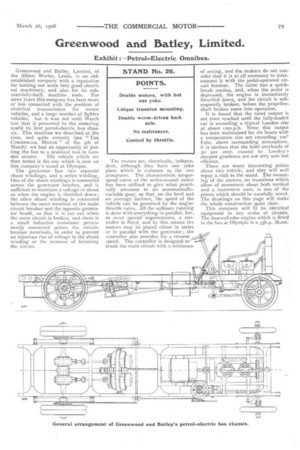Greenwood and Batley, Limited.
Page 25

If you've noticed an error in this article please click here to report it so we can fix it.
Exhibit :—Petrol-Electric Omnibus.
Greenwood and Batley, Limited, of the Albion Works, Leeds, is an oldestablished company with a reputation for turning out some very good electrical machinery, and also for its substantially-built machine tools. For some years this company has been more or less connected with the problem of electrical transmission for motor vehicles, and a large number of lighter vehicles, but it was not until March last that it presented to the motoring world its first petrol-electric bus chassis. This machine we described at the time, and quite recently (see "THE COMMERCIAL MOTOR 1' of the 5th of March) we had an opportunity of putting the bus to a practical test in Lon don streets. The vehicle which we then tested is the one which is now on this company's stand at Olympia. The generator has two separate shunt windings, and a series winding. One of the shunt windings is connected across the generator brushes, and is sufficient to maintain a voltage of about 20 when the engine is throttled down ; the other shunt winding is connected between the outer terminal of the main circuit breaker and the opposite generator brush, so that it is cut out when the main circuit is broken, and there is a small inductive resistance permanently connected across the circuitbreaker terminals, in order to prevent an injurious rise of voltage in the shunt winding at the moment of breaking the circuit.
The motors are, electrically, independent, although they have one yoke piece which is common to the two armatures. The characteristic torquespeed curve of the series-wound motor has been utilised to give what practically amounts to an automaticallyvariable gear, so that, on the level and on average inclines, the speed of the vehicle can be governed by the engine throttle valve. All the ordinary running is done with everything in parallel, but, to meet special requirements, a controller is fitted, and by this means the motors may be placed either in series or in parallel with the generator; the . controller also provides for a reverse speed. The controller is designed to ' break the main circuit with a minimum of arcing, and the makers do not consider that it is at all necessary to interconnect it with the pedal-operated circuit breaker. The latter has a quickbreak motion, and, when the pedal is depressed, the engine is immediately throttled down, and the circuit is subsequently broken, before the propellershaft brakes come into operation. It is found that the rated output is not even reached until the fully-loaded car is ascending a typical London rise at about 12m.p.h. Since this output has been maintained for six hours with a temperature rise not exceeding roe Fahr. above surrounding atmosphere, it is obvious that the brief overloads of 50 per tent. caused by London's steepest gradients are not only safe but efficient.
There are many interesting points about this vehicle, and they will well repay a visit to the stand. The mounting of the motors, on trunnions which allow of movement about both vertical and a transverse axes, is one of the points which should be carefully noted, The drawings on this page will make the whole construction quite clear. This company will fit its electrical equipment to any make of chassis. The four-cylinder engine which is fitted to the bus at Olympia is a 35h.p. Mutel.




































